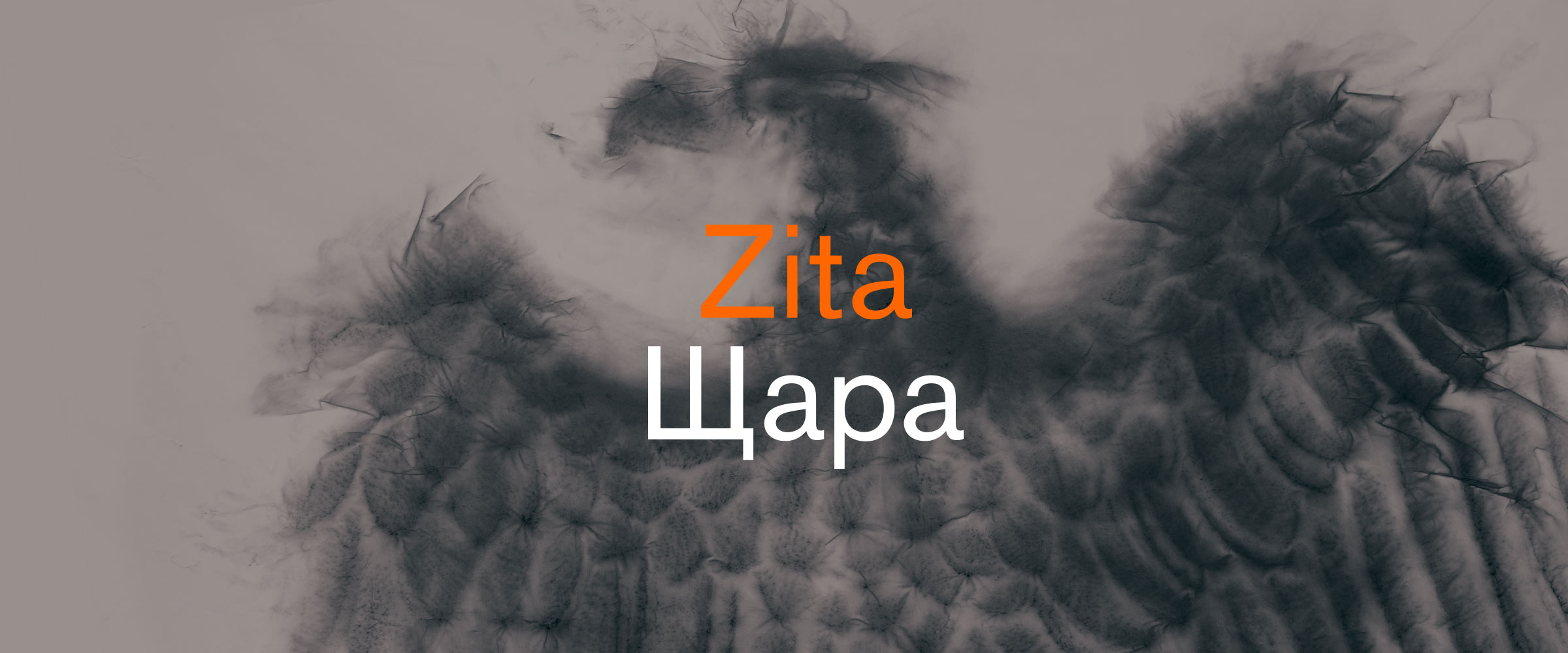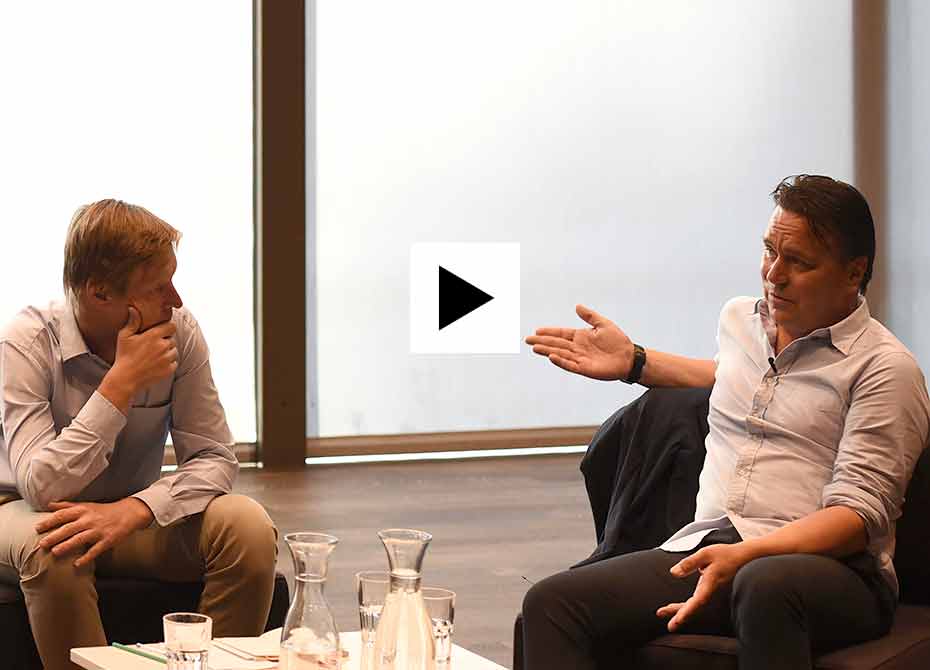The skilled dramaturgy that extends through these three rooms with just seven works generates a subtly foreboding atmosphere, and what initially looks like a domestic scenario soon reveals its true colours as a highly explosive ambience. The works of art take the parts of protagonists in this chamber piece. Fritsch’s faceless figures with immaculate surfaces meet powerful sculptures by Koschkarow that are loaded with pathos formulas and historical references. The interactions and the interplay of the protagonists raise topics such as displacement, isolation, violence, the misuse of power, and death: issues that have always preoccupied humankind but that have taken on a shocking new relevance in our own time. The names in the two-word title inspired this joint project; besides evoking historical references – Zita of Bourbon-Parma was the last Empress of Austria, the Щapa (Shchara in English) is a river in Belarus – they also have personal associations with memories and experiences for Katharina Fritsch and Alexej Koschkarow.
Past exhibitions: 2016
ZITA – ЩAPA
Chamber Piece by Katharina Fritschand Alexej Koschkarow12 June – 2 October 2016
With Zita – Щapa Schaulager presents a three-room installation by Katharina Fritsch (*1956 Essen, Germany) and Alexej Koschkarow (*1972 Minsk, Belarus). The new sculptures and drawings created for this presentation are the outcome of the artists’ intense exchange of ideas and concepts.
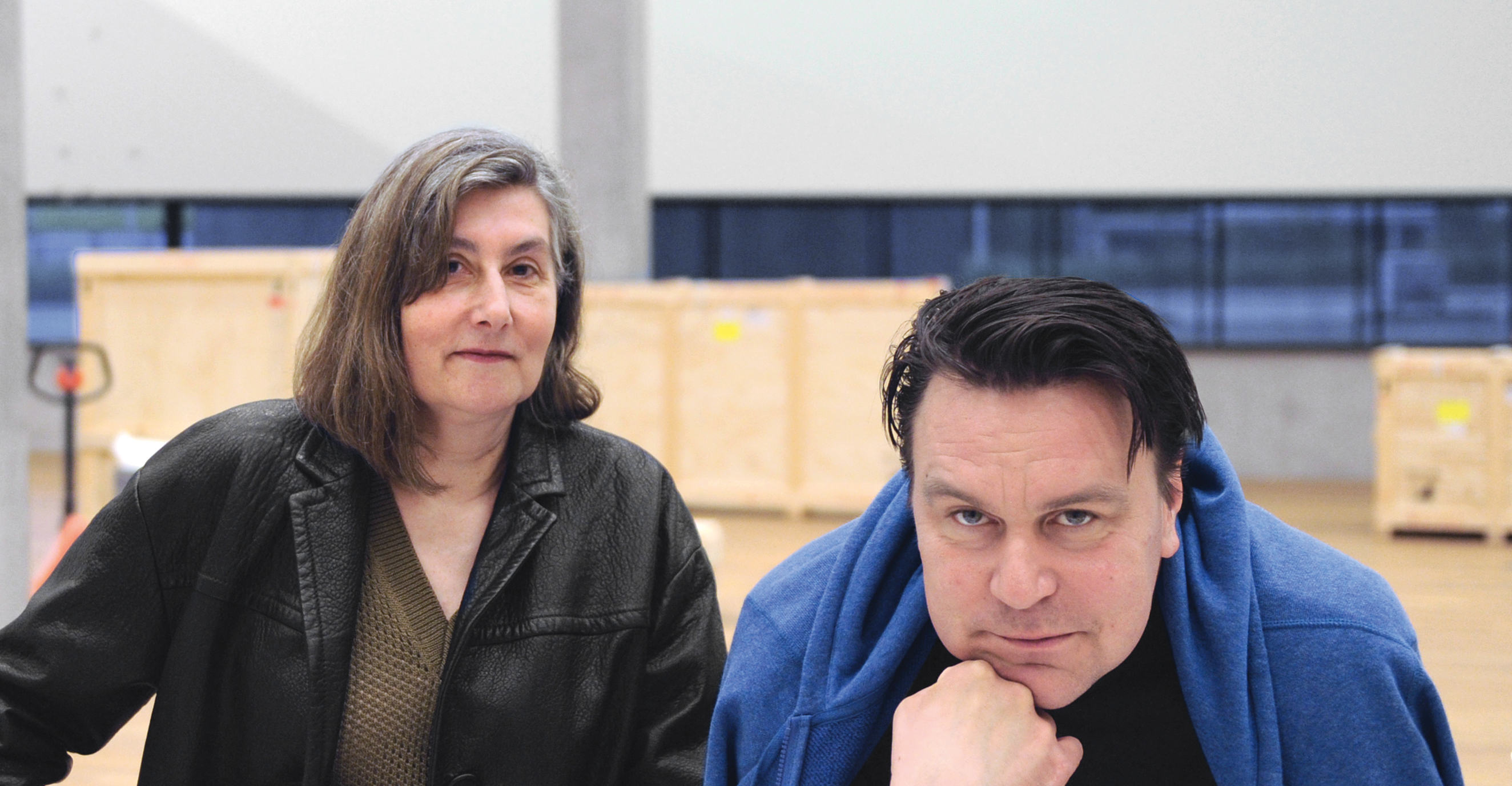
Katharina Fritsch
After having studied history and art history at the University of Münster, Katharina Fritsch, born 1956 in Essen (Germany), studied from 1977 in the class of Fritz Schwegler at the Kunstakademie Düsseldorf until 1984. Since the mid-1980s, she has exhibited regularly both at home and abroad: at the Kunsthalle Basel, for instance, in 1988; her first US solo exhibition took place at Dia Art Foundation in New York in 1993. Fritsch represented Germany at the 46th Venice Biennale in 1995, followed by an important solo exhibition in 1996 at the Museum of Modern Art in San Francisco, which went on to the Museum für Gegenwartskunst in Basel in 1997. Retrospectives were held in 2001 at Tate Modern in London, in 2002 at the K21 in Düsseldorf, and in 2009 at the Kunsthaus Zürich, and subsequently exhibited at Deichtorhallen in Hamburg. In 2013 her contribution Hahn/Cock to the Fourth Plinth in London’s Trafalgar Square caused a sensation. Katharina Fritsch taught as Professor of Sculpture at the Kunstakademie Münster from 2001 to 2010, and since 2010 she has held a professorship at the Kunstakademie Düsseldorf, the town where she lives.
Alexej Koschkarow
After having studied for two years at the Academy of Fine Arts in Minsk, Alexej Koschkarow, born 1972 in Minsk (Belarus), went to Germany to study with Fritz Schwegler at the Kunstakademie Düsseldorf from 1993 to 1999. In his final year, he was invited by Katharina Fritsch for a collaborative exhibition entitled “Damenwahl” at the Kunsthalle Düsseldorf. The following year, Koschkarow invited about thirty friends to the Malkasten art space in Düsseldorf: Tortenschlacht (2001) is the video documentation of this event, during which the elegantly dressed guests started to throw cream pies provided for this purpose. More solo and group exhibitions followed, among others in 2001 at Haus Fürstenberg, Sammlung Ackermans at Xanten, at the Galerie Jablonka Luhn in Cologne in 2002, 2003 and 2005, and “Situation Comedy: Humor in Recent Art” at the Contemporary Museum in Honolulu, also in 2005. His works were part of the 10th Triennale der Kleinplastik in Fellbach in 2007, and in 2008 “Take Me There (Show Me The Way)” at the Haunch of Venison in New York. In 2009, Viafarini in Milan presented “Checkpoint Charly”. Alexej Koschkarow lives and works in New York.
At first we just wanted to make a small model,
like a dollhouse.
Katharina Fritsch / Alexej Koschkarow
A three-part structure stands isolated on the expansive ground floor of Schaulager. Dwelling-like in dimension, the volume is closed on all sides apart from a front-facing entrance. On entering this “house within a house”, visitors are confronted with an altered spatial situation. The scene-like arrangement and proximity of the seven works in Zita – Щapa suggest an ensemble on stage. Chamber Piece borrows another strategy from the world of theatre in its concentration on the interaction of individual protagonists. The prevailing emotional and expressive mood that settles over the installation is further intensified by the distanced and precise forms.
The size and proximity of the works call for a direct encounter. As though on a stage, a mise-en-scène is underway, of which visitors become a part.
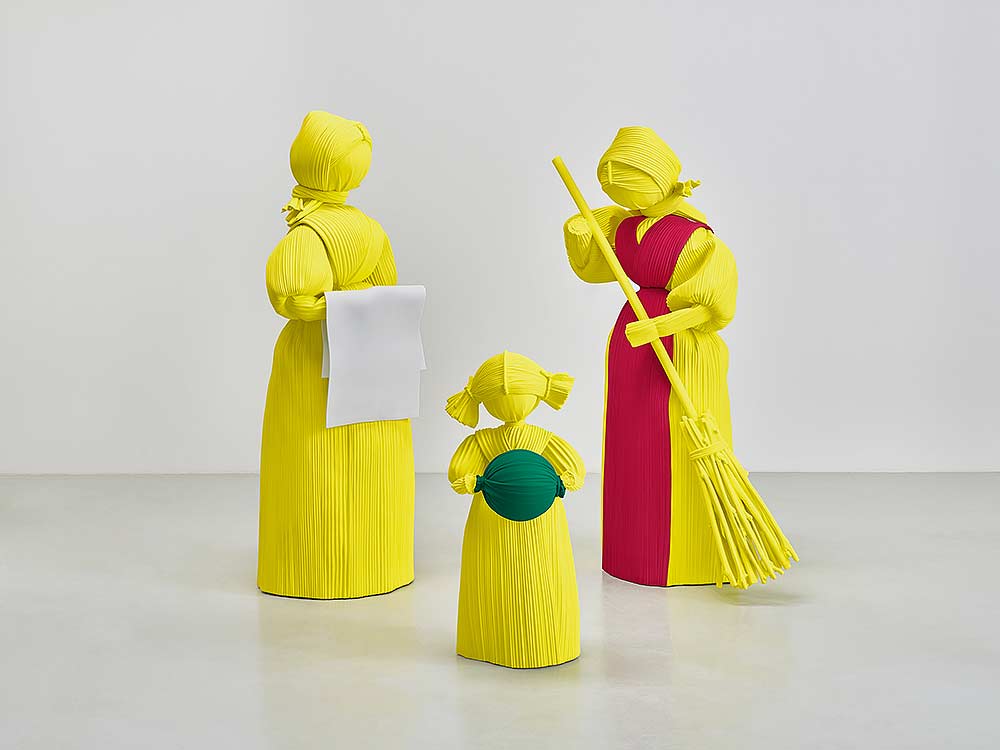
Katharina Fritsch
Puppen [Dolls], 2016
Epoxy resin, polyurethane, acrylic
Collection of the artist
The group of figures Puppen (Dolls, 2016) by Katharina Fritsch assumes a luminous presence in the central room of the Chamber Piece with an intense shade of yellow. The proportions and the round volumes are taken from a specific model: small corn-husk dolls produced in Eastern Europe, typically as souvenirs or nativity figures. In an elaborate working process, Fritsch has enlarged them and reduced them to the essentials. Converted to monochrome plasticity, any intimation of organic character gives way to an artificial presence. Through their specific attributes – aprons, headscarves, and utensils – the figures open up a context evoking traditional, rural, and domestic realms.
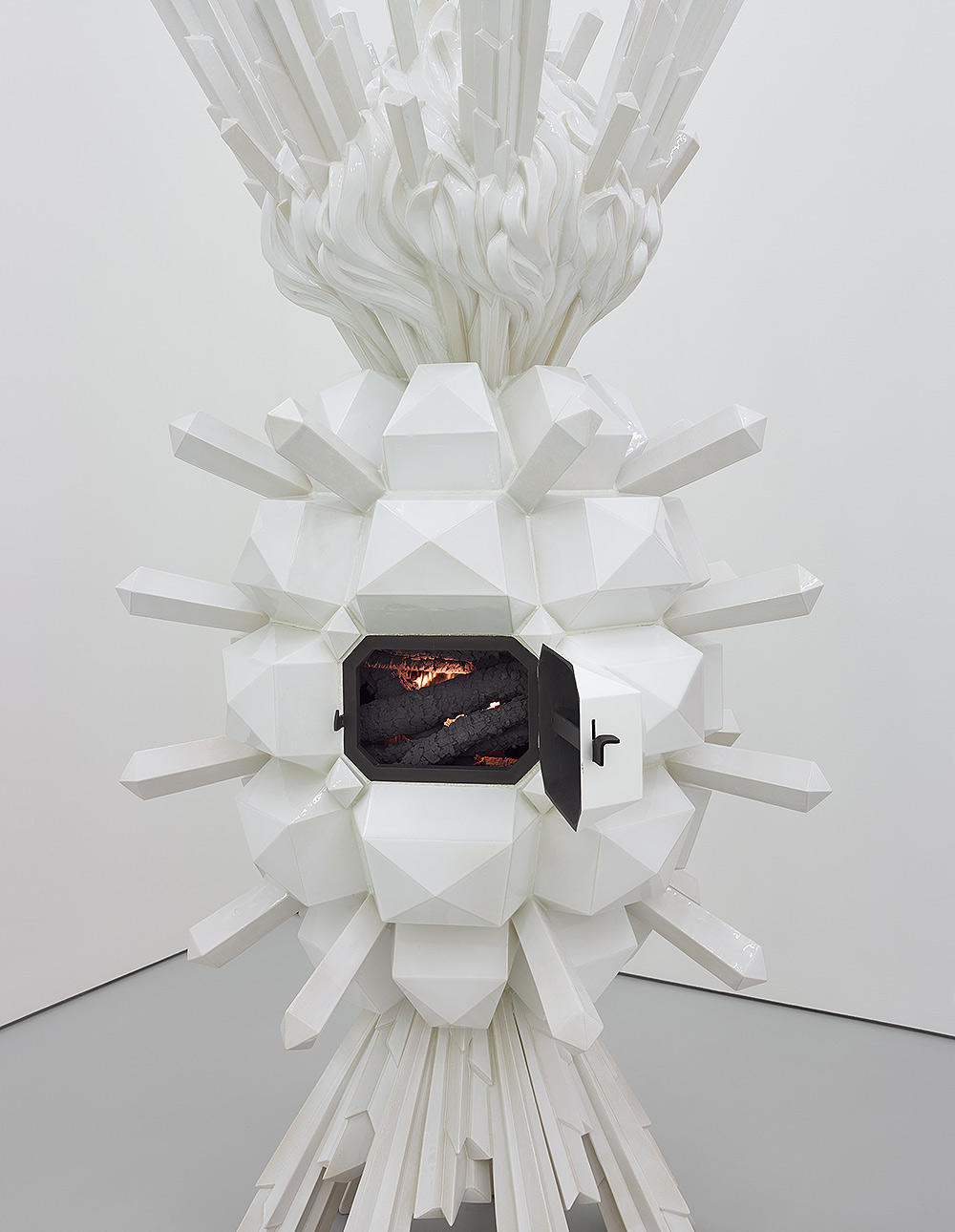
Alexej Koschkarow
Kalter Ofen [Cold Oven], 2016
Ceramics, metal, electric light, motor
Collection of the artist
Diagonally opposite Katharina Fritsch’s Puppen (Dolls, 2016) is Alexej Koschkarow’s ceramic sculpture Kalter Ofen (Cold Oven, 2016), modelled in equal measure on a cosy tiled stove and an exploding hand grenade. Like a lenticular image, both identities are simultaneously perceivable even though the associated functions have been negated.
Through the opened door of the stove, a smouldering fire can be made out underneath the black, charred logs, but without generating any warmth, just as the grenade’s explosion is flash-frozen in white glazed ceramic and does not continue its outward trajectory.
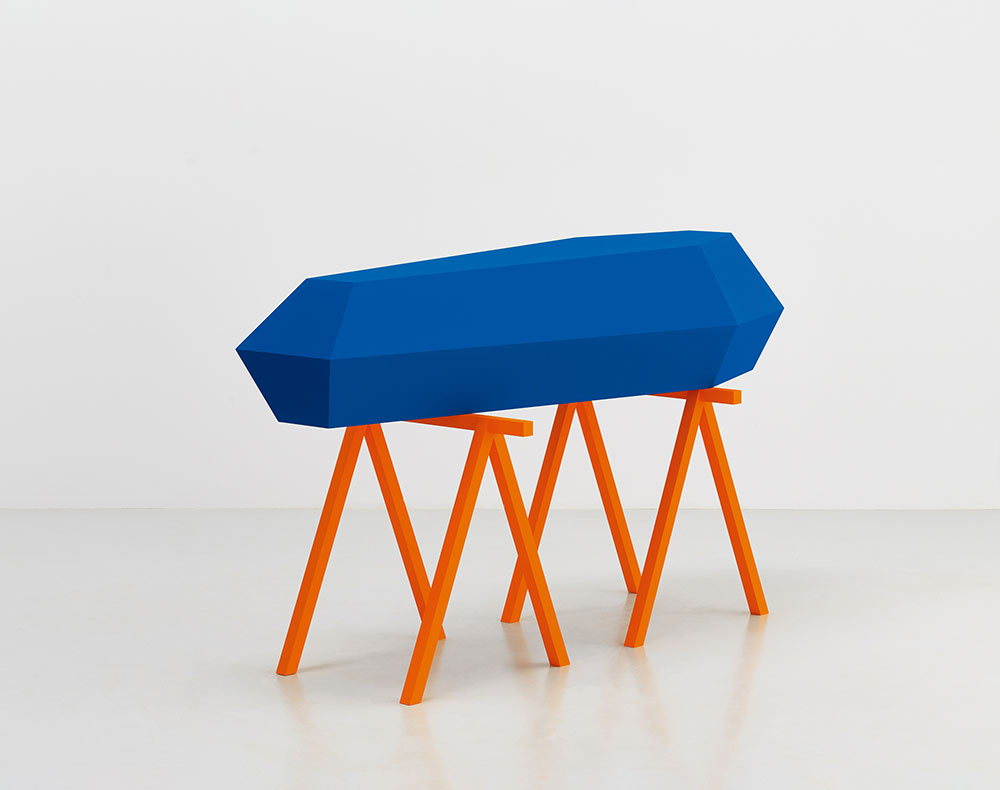
Katharina Fritsch
Sarg Coffin], 2016
MDF, blockboard, acrylic
Collection of the artist
Off to the left, a narrow door opening leads to the smallest of the chambers. The sculpture Sarg (Coffin, 2016) by Katharina Fritsch occupies the space. Though instantly identifiable as an object with a specific function, the prototypical simplification causes it to be perceived first and foremost as a constructivist object made of geometric forms and monochrome planes of colour, with its meaning receding in importance. The non-textured surfaces are matte without any reflection, as is typical of Fritsch’s sculptures. The intensive contrast of colours could hardly be more different from the heaviness usually associated with a coffin and from black as the colour of mourning. Remarkably present yet materially removed, Fritsch has created a work full of explosive force, which is unleashed in the intimate setting of the Chamber Piece.
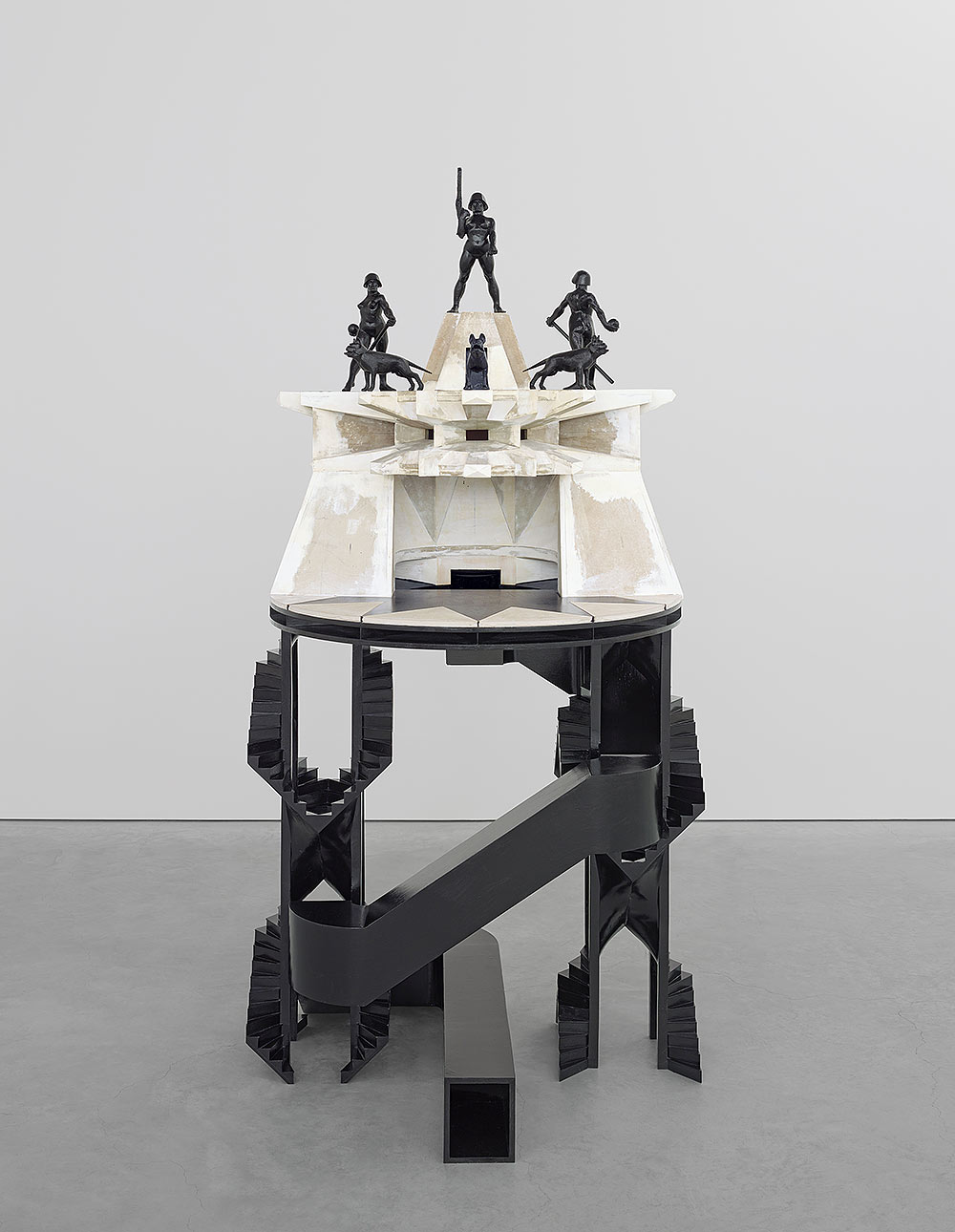
Alexej Koschkarow
Das was keinen Namen hat [Which Has No Name], 2016
Mixed media
Collection of the artist
In the manner of an eclectic architectural model, the sculpture Das was keinen Namen hat (Which Has No Name, 2016) in the right room of the Chamber Piece is composed of several, in fact incompatible elements. A massive bunker with embrasures forms the central structure with an opening that recalls the gaping maw of a rearing cobra, for example. Compared to this “upper body” – interpreting the sculpture as an animated creature – the foundation comes across as downright playful with a spiral-shaped shaft and two intertwined staircases. As the crowning element above, athletic females stand in a heroic pose with almost masculine facial features, clad in nothing but martial steel helmets. As an ambiguous personification, albeit one trivialized to the status of a pin-up, the he-women embody a type of female that could hardly be more opposed to the domestic, motherly image of the corn-husk dolls.
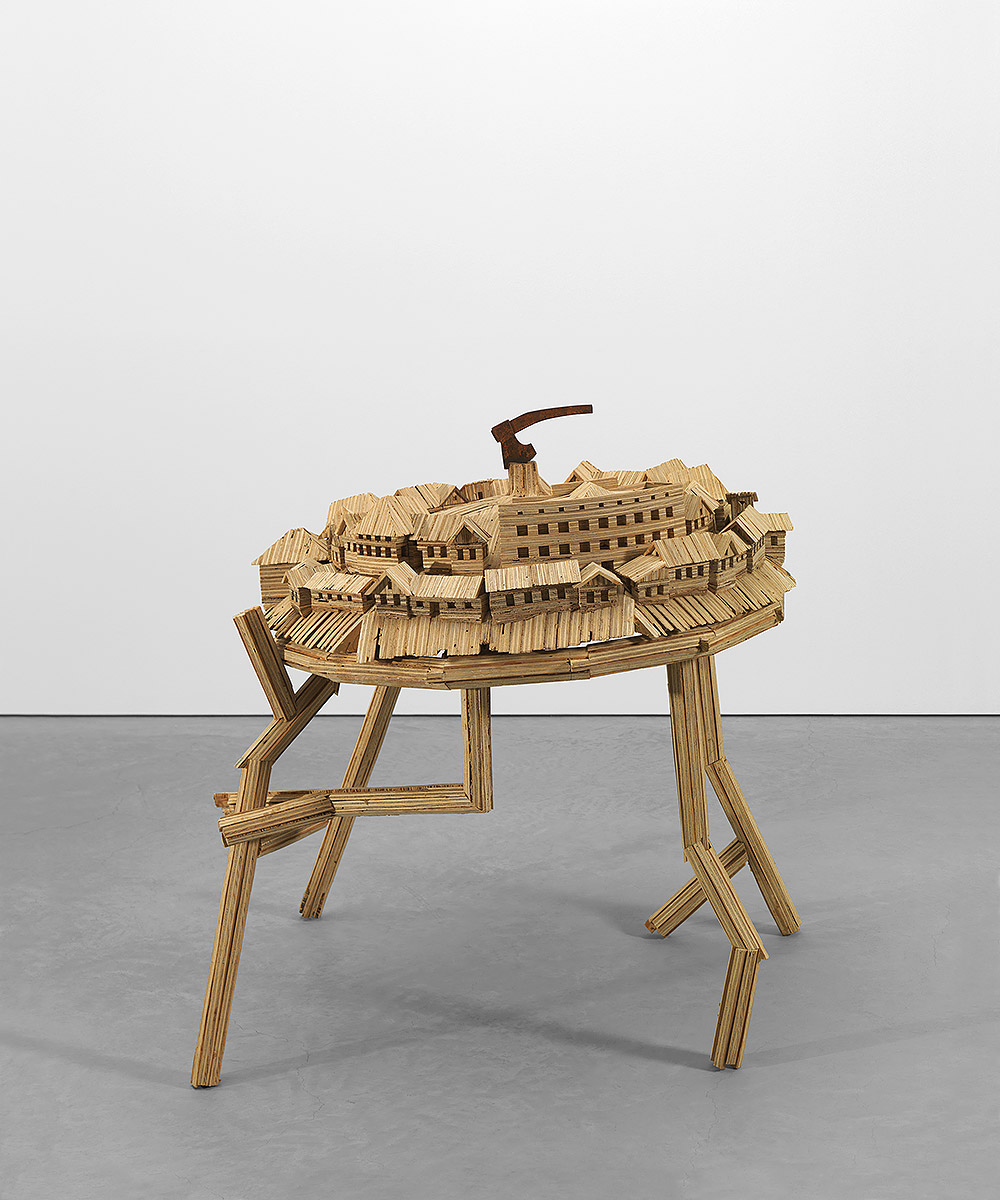
Alexej Koschkarow
Schtetl [Shtetl], 2012
Wood and metal
Emanuel Hoffmann Foundation, on permanent loan to the Öffentliche Kunstsammlung Basel
In Schtetl (Shtetl, 2012), constructed from countless small pieces of wood, two dense rings of houses line a central town square. The rural impression is reinforced by the title with its reference to a historic type of Jewish settlement, the shtetl. Prevalent throughout Eastern Europe for centuries, these traditional Jewish village communities came to an abrupt end amidst the horrors of the Second World War. Yet long before then, the shtetl had found its way into literature and art as the – occasionally idealized – epitome of a real and true way of life. With the axe prominently placed in the centre of the village, Alexej Koschkarow gives these ambivalences a compelling form in his sculpture. With the simple, yet very precisely deployed material – having reused wood from the floor of his studio in a Hasidic neighbourhood of Brooklyn – he also establishes a link to Jewish emigration to the USA.
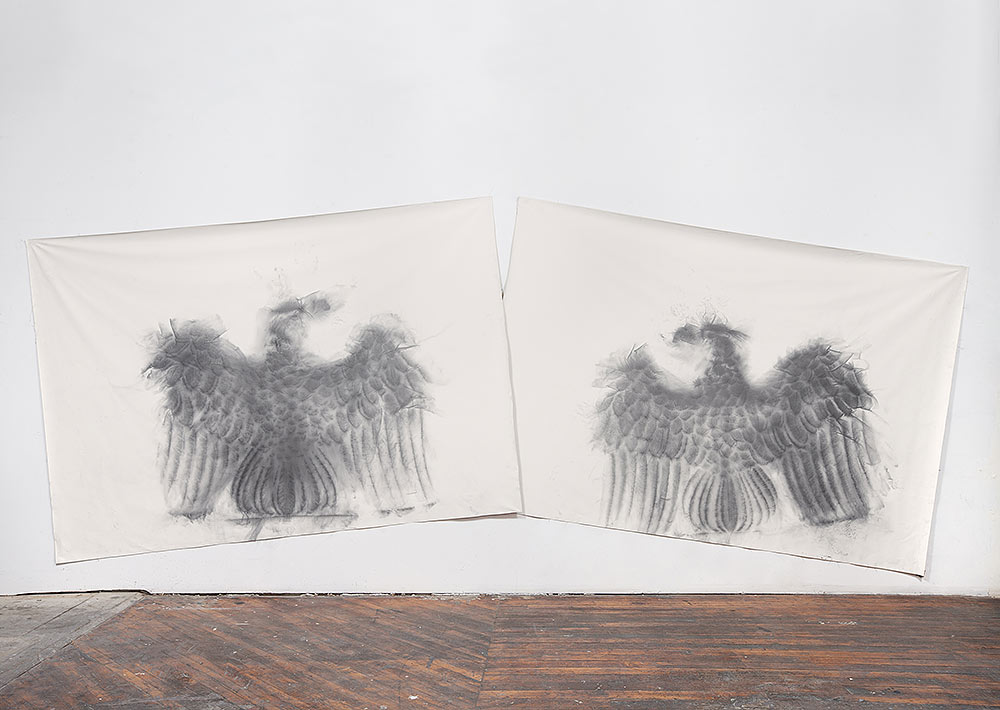
Alexej Koschkarow
Bellevue 2014
Smearing
Graphite on primed canvas
Collection of the artist
The sculptures are bordered on both sides by graphite frottage works on large-format canvases. Referring to these works as “smearings”, the artist uses a rubbing technique to transfer the surfaces of architectural elements, such as doors or façade sections, as well as publicly accessible sculptures onto canvas in original scale. Converted into two-dimensionality, the rubbings show dusky, shadow-like forms. The eagle motif of Bellevue (2014) is taken from stone sculptures in New York.
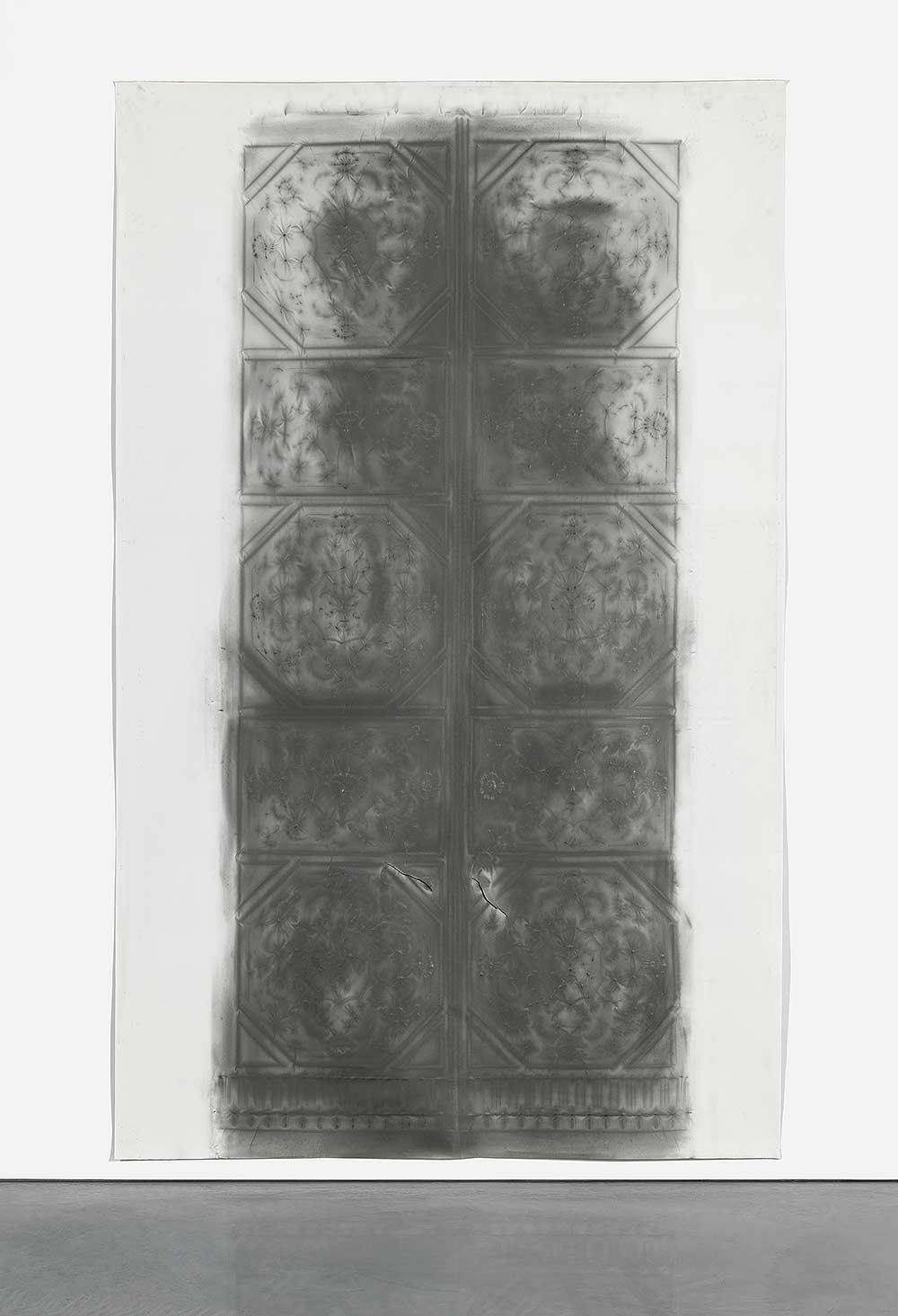
Alexej Koschkarow
Höllentor [Gates of Hell], 2012
Smearing
Graphite on primed canvas
Emanuel Hoffmann Foundation, on permanent loan to the Öffentliche Kunstsammlung Basel
Hung opposite is the upright-format Höllentor (Gates of Hell, 2012). The title recalls Auguste Rodin’s somber bronze work The Gates of Hell (1880–1917), but the rubbing is actually from the doorway of a historic building in New York. With the smearings, Koschkarow blurs clear-cut categorizations and sharpens the viewer’s eye for the overtones associated with a motif.
The clear and precise structure of Zita – Щapa is matched by the multilayeredness of its impact. What appears unambiguous at first glance reveals an ambivalence and multiplicity of meanings. The familiar and domestic become uncanny. The double title of this unwritten piece is loaded with an abundance of references, albeit ones not directly formulated in the installation. Rather, they function as cues for a game of symmetries and disruptions, correspondences and contradictions, allusions and references.
This name, Zita, became a symbol for me of what I was imagining, Austria,
the First World War, the situation today.
Katharina Fritsch
Zita did not work for me at all. That’s why I chose Щapa. I like that fact
that most people think it’s the Russian translation of Zita. This false
symmetry.
Alexej Koschkarow
The historic figure Zita of Bourbon-Parma (1892–1989) briefly occupied the stage of world affairs together with Emperor Charles I as the last Austro-Hungarian imperial couple during the latter years of the First World War. With the lost war and the demise of the dual monarchy in autumn 1918, Zita and her husband were forced into exile. Zita’s life encompassed multiple epochs of fundamental upheavals in the balance of power within Europe and especially in Eastern Europe: from the First World War, the collapse of the monarchy and the Austrian multinational state, and the Second World War, up to the eve of Communist Europe’s collapse. Never ceasing to maintain her family’s claim to the throne, Zita was kept from returning to Austria until late in her life. In the spring of 1989 she was buried in Vienna with a quasi-imperial funeral. Yet Zita is also an Italian saint from the thirteenth century regarded as a patron saint of maids and domestic servants.
Serving as the counterpart in the title, the river Щара (in English Shchara) is situated in western Belarus as one of some 20,000 Belarusian rivers, which also include much more well-known rivers such as the Dnieper or the Pripyat. The Shchara was a theatre of war in the First and Second World War and evokes the eventful and changing history of present-day Belarus, particularly its western region. In both wars, the area was the site of entrenched battles between German and Russian troops. The meandering course of the Shchara and its banks lined with impenetrable woods and swamplands made it a line of defence and, especially in the Second World War, a refuge for partisans. Alexej Koschkarow has a connection to the river through his family history: his great-grandfather was wounded there during the First World War. The personal association is anchored as a footnote in the great flow of history, whose course has been cyclically inscribed with wars and changing balances of power.
Zita – Щapa invites viewers to immerse themselves in an atmospheric visual environment replete with cultural and historical references to themes such as fear, displacement, homelands, exile, oppression, power, violence, and death; themes that are as timely today as ever. The artful staging set in motion by Chamber Piece remains open to far more than just one conclusion.
The artistic exchange between Katharina Fritsch and Alexej Koschkarow began in the 1990s. After two years at the Academy of Fine Arts in Minsk, Koschkarow studied until 1999 at the Kunstakademie Düsseldorf – where Fritsch, still today a resident of this city, completed her education in the 1970s. At Fritsch’s invitation they presented their works together for the first time in 1999 at the Kunsthalle Düsseldorf. In 2012 the artists repeated their interplay in a Düsseldorf gallery. Now in their third and closest collaboration at Schaulager, the artists again remain true to the principle of showing individually created pieces. The works that come together in the installation were produced independently of one another in the studio and appear as autonomous artistic positions.
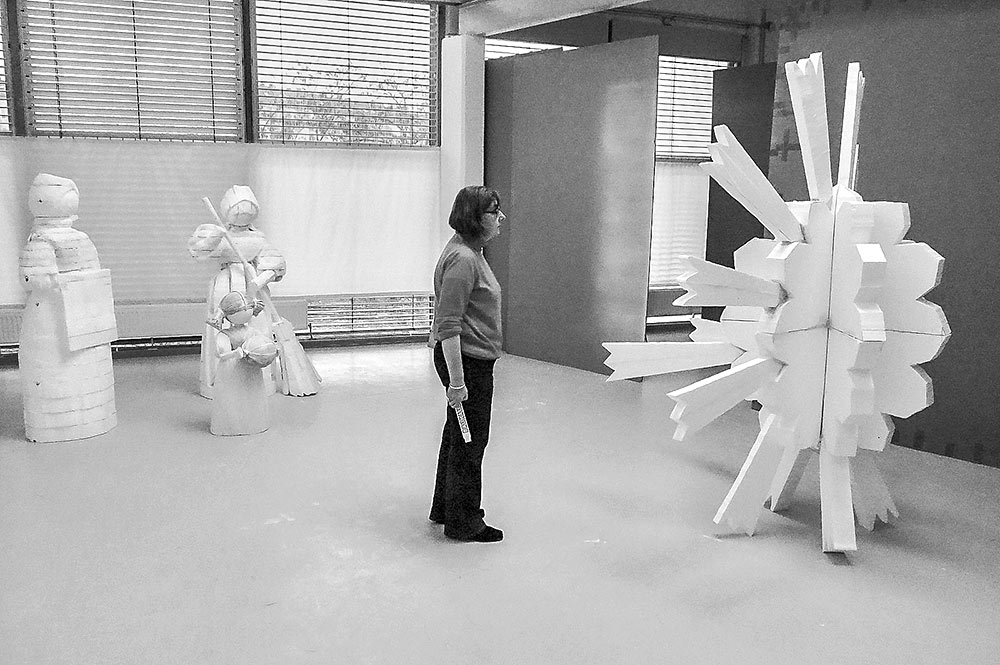
The starting point for my artistic work is always something that can be seen, never something literary. I always proceed from my own eyes – I do not go over and read a book first.
Katharina Fritsch
The studio is a vast terrain of freedom where things can be approached
and engaged in a playful way.
Katharina Fritsch / Alexej Koschkarow
We work with contemporary materials, with materials available in this day and age. That includes 3-D printing as well as bronze casting. Many things coexist side by side. Artistic work brings a multitude of things together like no other kind of work.
Katharina Fritsch / Alexej Koschkarow
Nevertheless, the concept of Zita – Щapa, the coordination of the individual works, and their elaborate execution are based on an intensive ongoing exchange. The artists are interested in the tension between their distinctive working methods. Fritsch’s objects come across as a coherent whole and are immediately recognizable, while the immersion in Koschkarow’s works takes more time due to their multipartite nature. From the idea to the execution, the works of both artists arise in constant confrontation with questions of material, form, and colour – a differentiated creative process characterized by the precise deployment of elaborate artistic techniques.
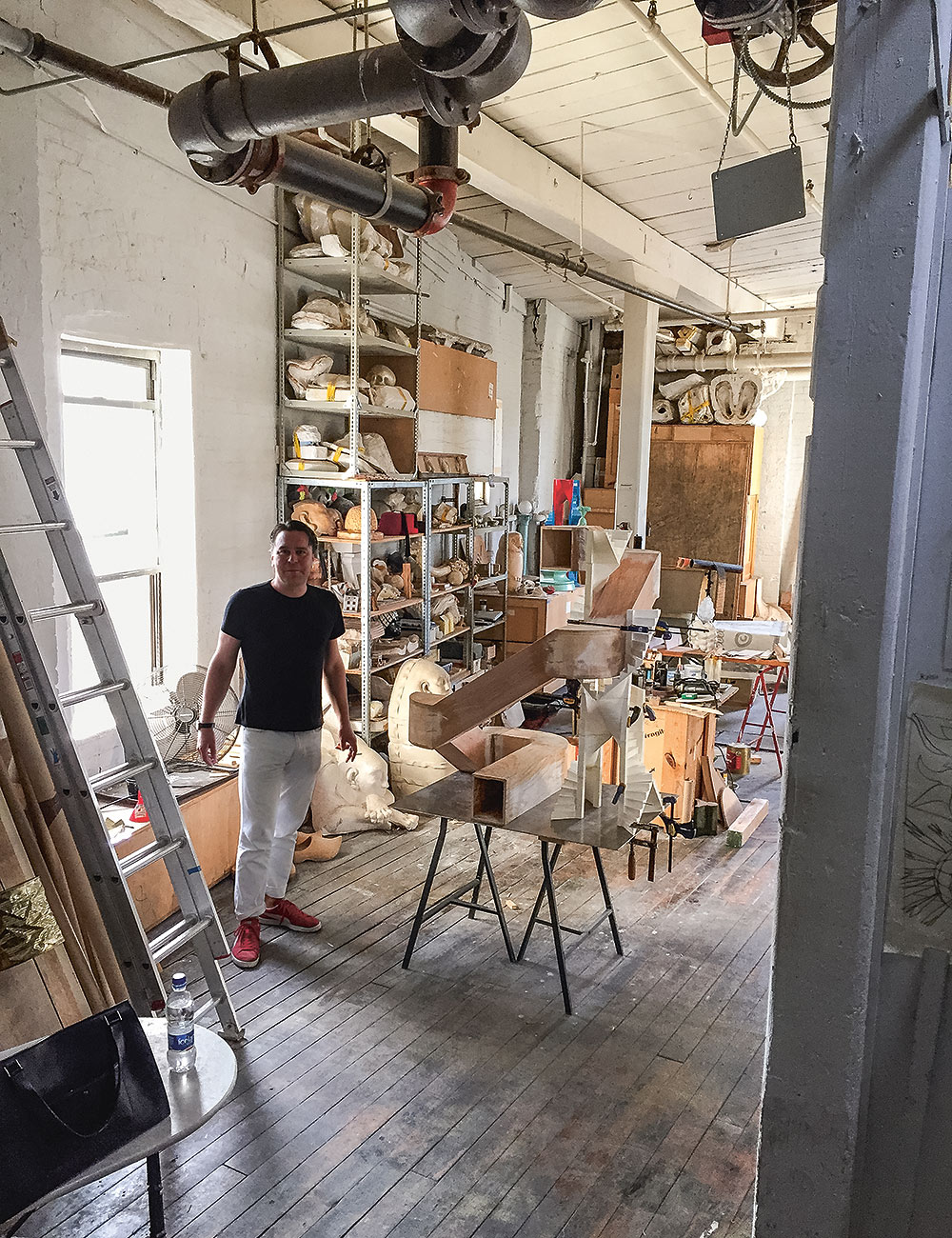
Downloads
- Exhibition Leaflet(pdf, 574.87 KB)
- Exhibition Guide(pdf, 190.09 KB)
Catalogue
Parallel to the preparations for Zita – Щара, an elaborately designed catalogue has been produced in close cooperation with the two artists, which reflects, in its contents and scope, the complexity and multidimensionality of the exhibition at Schaulager. Katharina Fritsch and Alexej Koschkarow follow quite different artistic approaches, establishing an intriguing tension that is heightened by the characteristic precision and meticulousness of their respective working methods. Extensive sequences of photographs, taken in real time, as it were, when the artists were creating their “chamber piece”, offer an exceptional insight into the genesis of the works and the manner of their making. Four authors – Jacqueline Burckhardt, Robert Fleck, Julian Heynen and Michael Rooks – explore the various aspects of Zita – Щара. A series of large-format installation views, capturing the aesthetic concentration of the exhibition, rounds the catalogue off.
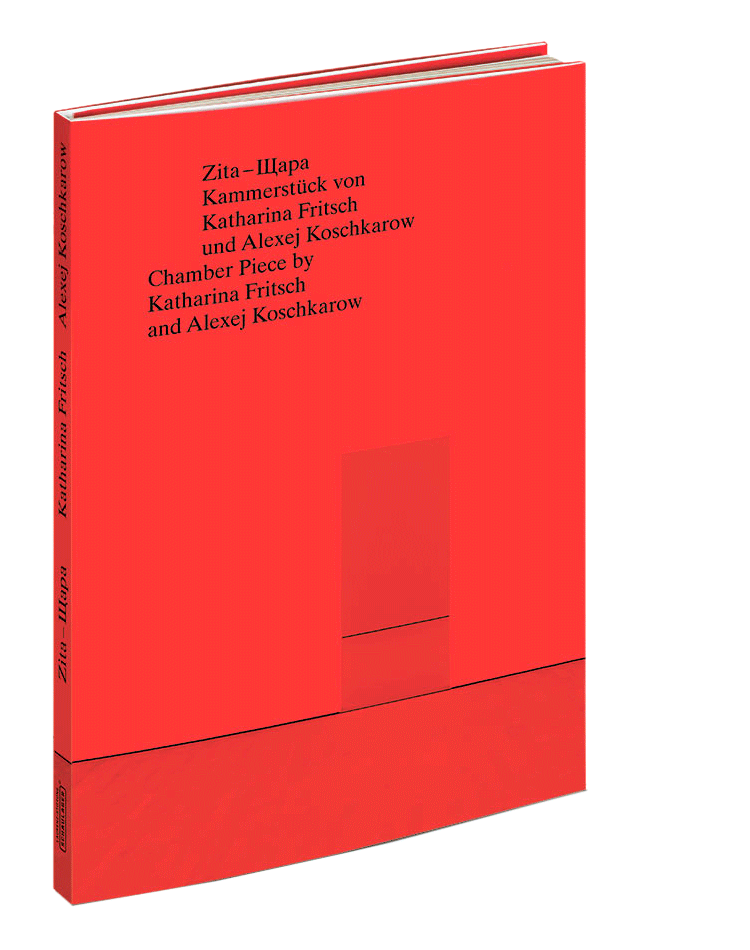
Zita – Щapa.
Chamber Piece by Katharina Fritsch and Alexej Koschkarow
Herausgegeben von der Laurenz-Stiftung, Schaulager
mit einem Vorwort von Maja Oeri
Contributions by
Julian Heynen – Spectral Realism
Jacqueline Burckhardt – “Whereof one cannot speak ...”
Robert Fleck – Art as an Open Metaphor
Michael Rooks – Zita – Щapa “... a broad and mighty river ...”
168 pages, 21 × 30 cm, approx. 160 full-colour illustrations
Hardcover with dust cover, bilingual German/English
CHF 28.00

